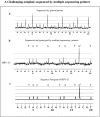Type-specific multiple sequencing primers: a novel strategy for reliable and rapid genotyping of human papillomaviruses by pyrosequencing technology
- PMID: 15858143
- PMCID: PMC1867525
- DOI: 10.1016/S1525-1578(10)60546-6
Type-specific multiple sequencing primers: a novel strategy for reliable and rapid genotyping of human papillomaviruses by pyrosequencing technology
Abstract
DNA sequencing is the gold standard method for accurate microbial and viral typing. However, DNA sequencing techniques have been facing limitations in typing of human papillomaviruses when the specimen harbors multiple genotypes and yields nonspecific amplification products, resulting in nonspecific and noninterpretable sequence data. To address these limitations we have developed a type-specific multiple sequencing primer DNA-sequencing method. This new strategy is suitable for sequencing and typing of samples harboring different genotypes (co-infections with multiple genotypes) and yielding nonspecific amplifications, thus eliminating the need for nested polymerase chain reaction (PCR), stringent PCR conditions, and cloning. The new approach has also proved useful for amplicons containing low PCR yield or subdominant types, avoiding reperforming of amplifications. We have applied the multiple sequencing primer method for genotyping of clinically relevant human papillomaviruses in a clinical test panel by using a combined pool of seven type-specific sequencing primers for HPV-6, -11, -16, -18, -31, -33, and -45. Furthermore, we introduced a sequence pattern recognition approach when there was a plurality of genotypes in the sample to facilitate typing of more than one target DNA in the sample. The multiple sequencing primer method has proved to be a multifaceted approach for typing of human papillomaviruses by DNA sequencing technologies.
Figures






References
-
- Gharizadeh B, Kalantari M, Garcia CA, Johansson B, Nyren P. Typing of human papillomavirus by pyrosequencing. Lab Invest. 2001;81:673–679. - PubMed
-
- Gharizadeh B, Ghaderi M, Donnelly D, Amini B, Wallin KL, Nyren P. Multiple-primer DNA sequencing method. Electrophoresis. 2003;24:1145–1151. - PubMed
-
- zur Hausen H. Papillomaviruses causing cancer: evasion from host-cell control in early events in carcinogenesis. J Natl Cancer Inst. 2000;92:690–698. - PubMed
-
- Milde-Langosch K, Riethdorf S, Loning T. Association of human papillomavirus infection with carcinoma of the cervix uteri and its precursor lesions: theoretical and practical implications. Virchows Arch. 2000;437:227–233. - PubMed
-
- van Doorn LJ, Kleter B, Quint WG. Molecular detection and genotyping of human papillomavirus. Expert Rev Mol Diagn. 2001;1:394–402. - PubMed
Publication types
MeSH terms
Substances
LinkOut - more resources
Full Text Sources
Other Literature Sources

